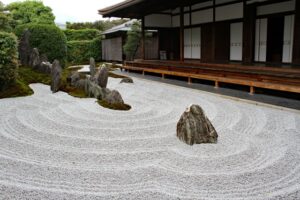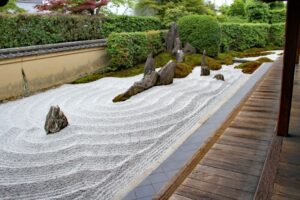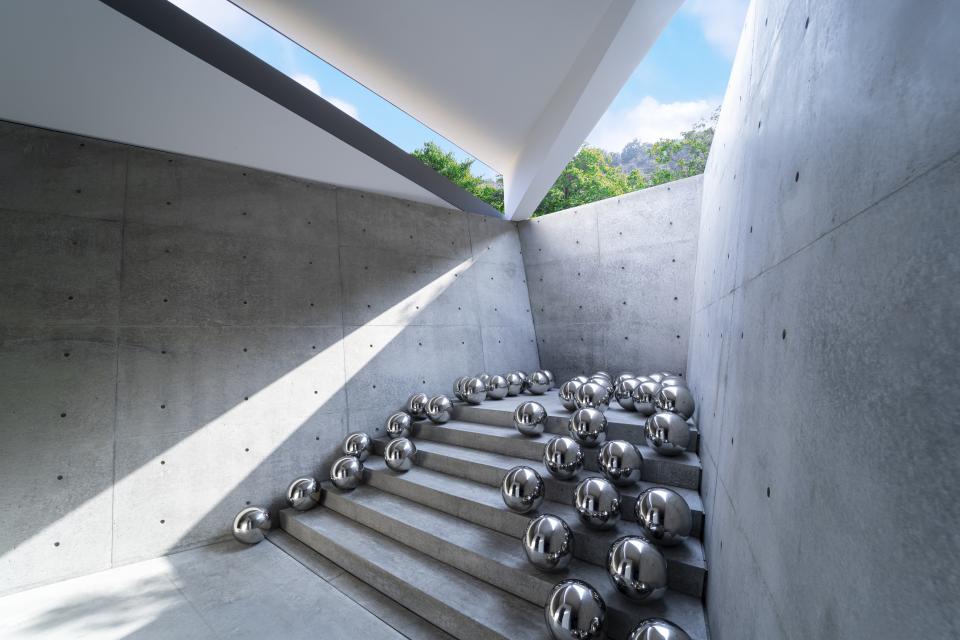The Art of Contemplation
In the spiritual heart of Japan, there is a type of garden that doesn’t aim to impress with colorful flowers or ornate fountains. Instead, it speaks through silence, order, and hidden symbolism. These are Zen gardens, or karesansui (枯山水): minimalist landscapes made of raked gravel, stones, moss, and sometimes small plants — designed to represent miniature natural scenes and invite deep calm.
Every element is placed with purpose, encouraging quiet reflection and inner balance.

What Is a Zen Garden?
A Zen garden is a carefully composed space that represents abstract natural landscapes using dry elements like rocks, gravel, and moss. Water is symbolized, not used. The patterns raked into the gravel evoke the flow of rivers or waves, while stones may represent islands, mountains — or even mythical creatures.
These gardens are not meant to be walked through, but observed quietly from a fixed point, like a three-dimensional painting made to be contemplated.
Origins and Philosophy
Zen gardens originated during the Muromachi period (1336–1573), when Zen Buddhist monks used them as tools for meditation. Deeply influenced by Zen, they promote simplicity, emptiness, and connection to the essential.
In their apparent austerity lies profound symbolic richness. Emptiness is not lack — it’s space for thought, feeling, and presence.

A Zen Haiku
古池や
蛙飛びこむ
水の音
An old pond —
A frog leaps in.
The sound of water.
— Matsuo Bashō
A Zen haiku captures a fleeting, simple, yet profound moment in just three lines (5-7-5 syllables). Rooted in Zen philosophy, these poems reflect nature, the present moment, and sudden insight — what Zen calls satori. Rather than being descriptive, they are contemplative, minimalist, and open to personal interpretation.
Must-See Zen Gardens in Japan
- Ryoan-ji (Kyoto)
The most iconic of all Zen gardens. It features 15 stones arranged on a sea of white gravel. No matter where you sit, you can never see all stones at once — a metaphor for the limits of human knowledge. - Daitoku-ji Temple (Kyoto)
A large temple complex with several sub-temples, each with its own Zen garden. The Zuihō-in sub-temple is especially recommended, blending tradition with unique symbolism. - Ginkaku-ji (Silver Pavilion, Kyoto)
Though not a dry garden entirely, it features symbolic elements like the Kōgetsudai — a white sand cone representing a moon-viewing mountain.
Hidden Zen Gardens Beyond the Usual Routes
- Zuihō-in Garden (Daitoku-ji, Kyoto)
Though located in Kyoto, Zuihō-in remains off the beaten path. Founded by a Christian feudal lord, its dry garden is intimate and meaningful, with rocks said to represent ships and spiritual journeys. - Ryoan-ji Garden of Yamaguchi
Not to be confused with the famous one in Kyoto, this temple in Yamaguchi Prefecture features a lesser-known Zen garden surrounded by native vegetation — offering a tranquil, authentic experience rarely visited by foreign tourists. - Kōmyōzen-ji Garden (Dazaifu, Fukuoka)
The only Zen-style dry garden on the entire island of Kyūshū. Located just behind the famous Dazaifu Tenmangū Shrine, it often goes unnoticed. Its patterns of sand and stones evoke flowing water and elemental harmony.
How to Experience a Zen Garden
- Go without rush. Take time to sit, breathe, and observe.
- Try to disconnect from your phone — this space is for reconnecting with yourself.
- Visit in the early morning or late afternoon for a more peaceful ambiance.
- Some temples offer meditation sessions facing the garden — a truly enriching moment.
A Mental Sanctuary
In a world overloaded with noise and stimuli, Zen gardens in Japan invite us to pause. They teach that in simplicity, there is beauty; in order, there is peace; and in silence, there is wisdom.
Let us help your travelers include these experiences in their itineraries — and offer them the chance to reconnect with themselves in serene, soul-nourishing surroundings.






